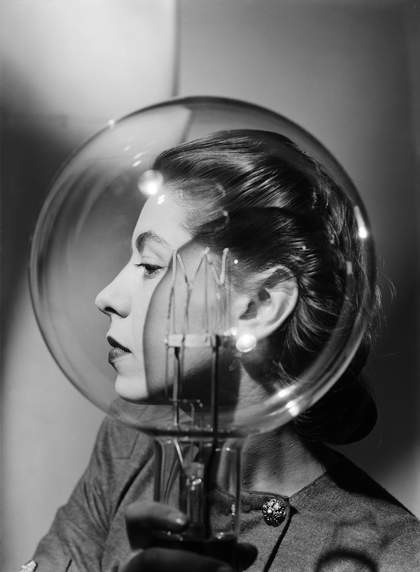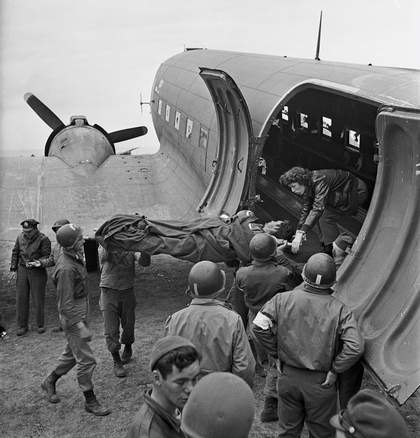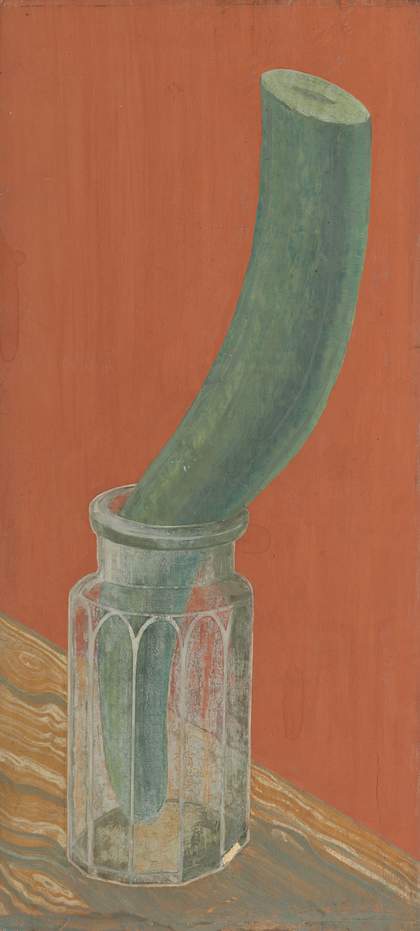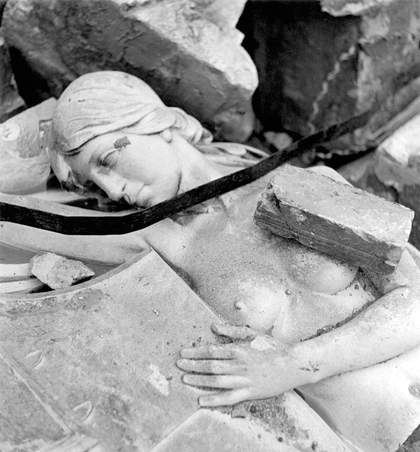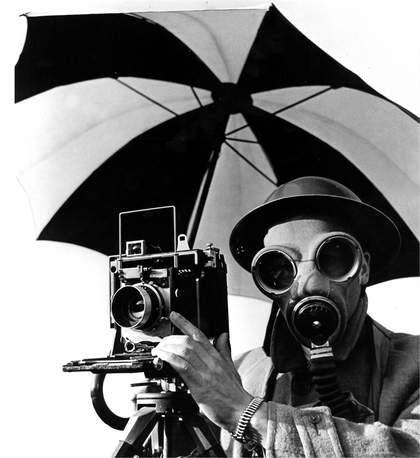
Lee Miller, David E. Scherman dressed for war, London 1942. Lee Miller Archives. © Lee Miller Archives, England 2025. All rights reserved. leemiller.co.uk
[I was] practically born and brought up in a dark room
Lee Miller
1. BEFORE THE CAMERA
Lee Miller’s first exposure to photography was as a model. Her father was a keen amateur photographer and she posed frequently for him from early childhood. She began modelling professionally in New York City in 1926 while studying painting at the Art Students League. In March 1927, she appeared on the covers of British and American Vogue, drawn in pearls and furs against a glittering city skyline.
Miller came of age at a time when femininity was being reimagined. A boyish, youthful style was fashionable, associated with greater freedoms for women. Tall and slender, with cropped hair, she embodied the androgynous beauty ideals of the 1920s. Born Elizabeth, Miller renamed herself ‘Lee’ around this time: snappy, modern and unisex, it better expressed her persona.
With professional photographic modelling in its infancy, she became one of its first stars. Through this role, Miller collaborated with some of the great artists of the 1920s and 1930s. These experiences inspired her to become a photographer herself, declaring she would ‘rather take a picture than be one.’ Moving to Paris in 1929, she apprenticed herself simultaneously to two of the city’s leading photographers, Man Ray and George Hoyningen-Huene. Performing for their cameras while also working as a studio assistant and trainee, she co-created some of the most iconic fashion images of her era. In an enterprising strategy, she also modelled for herself, publishing self-portraits in Vogue under her own byline.
2. DREAMING OF EROS
When Miller moved to Paris in the summer of 1929, she was determined to be an artist. Man Ray was at the heart of the city’s avant-garde circles, internationally renowned as a painter and photographer. She presented herself to him unannounced: ‘I told him boldly I was his new student. He said he didn’t take students and anyway he was leaving Paris for his holiday. I said, I know, I’m going with you – and I did.’ An explosive period of romantic connection and creative collaboration followed, as Miller and Man Ray took each other as subject and inspiration.
Miller soon outgrew her apprentice role, establishing her own studio in 1930, but the pair continued to work intimately in the studio and darkroom until 1932. This section brings together works attributed to both Miller and Man Ray, exploring their fluid artistic dialogue.
Each performed for the other’s lens, and for their own. Experimenting together with new processes, such as solarisation, they also shared studios, models, props and even cameras. Fascinated by the erotics of the body, they pushed the frontiers of photography to explore love, power and desire. With such closely entwined practices, it can be difficult to establish clear authorship. Miller later noted that some of her work was published as Man Ray’s, adding, ‘it doesn’t matter: I can’t claim anything: we were like one person when we were working.’
3. A SURREAL GAZE
Some of them are pictures I saw in my imagination, just as I would a painting, and I assembled the material for them
Lee Miller
The years 1929–32 were some of the most creatively fertile of Miller’s life. Establishing a studio in her Montparnasse apartment, she lived and worked at the centre of the Parisian avant-garde. Miller met and befriended artists associated with surrealism, a movement that rebelled against convention, embraced chance and asserted the power of the unexpected and the uncanny. Miller drew on these ideas as she developed her own independent artistic voice.
Turning her lens on the streets of Paris, Miller exploited the camera’s ability to free images from their familiar contexts, giving them new meanings. Crops, reflections, unusual juxtapositions and disorientating angles reveal a world of strange beauty. Statues spring to life and forms mutate. Enigmatic hands recur as a motif – grasping, reaching, penetrating, exploding and lecturing. Light and shadow dance rhythmically across the paper.
In the early 1930s, photography was still not widely recognised as an art form, championed only by a small international network of galleries and journals. Alongside modernist and surrealist peers, Miller’s work was published and exhibited in Paris, Marseilles, Brussels, London, Milan, New York and San Francisco. In late 1932, aged only 25, she moved back to New York and opened her first solo exhibition at the Julien Levy Gallery. One of the most important art dealers in the United States, Levy hailed her as ‘the new light on the horizon of photography’.
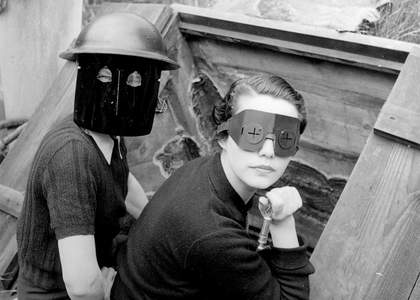
4. NEW VISIONS
Miller arrived in Cairo in September 1934, ready to begin a new chapter. She had spent the previous two years running a commercial studio in Depression-era New York, leaving her burnt out by the repetitive demands of high-profile clients and brands.
At first, Miller renounced photography entirely. Newly married to an Egyptian businessman, she no longer needed to earn a living. But a trip to Jerusalem in 1935 reignited her creative spark, and she returned to the camera as a tool of experiment and exploration. Over the next four years, Miller made regular expeditions across remote Egyptian deserts, as well as through Syria, Palestine, Lebanon, Cyprus, Romania and Greece. These trips fed her adventurous spirit and renewed her photographic practice. Alongside her own work, she became involved in Cairo’s radical art scene and helped establish the left-wing surrealist group Art et Liberté.
Miller recorded Egypt’s industrial modernity alongside its expansive landscapes and ancient ruins. Guided by her eye for double meaning, striking silhouettes and beguiling juxtapositions, she created enigmatic compositions with an uncanny charge. Torn screens, shrouded statues and fleshy rock formations evoke a world of shifting possibilities.
5. ARTISTS & FRIENDS
Famously charismatic and sharply intelligent, Miller counted many of the leading artists and intellectuals of her day as friends. Throughout her life, she collaborated with members of her sprawling community to create intimate, characterful portraits. Some were commissioned, while others were made for personal pleasure. Informed by her own experiences in front of the camera, she was adept at setting her subjects at ease. She explained: ‘It takes time to do a good portrait … [and] find out what idea of himself or herself he has in mind.’ These images were carefully staged and composed. They invite us into her sitters’ inner worlds, hinting at their creative lives in ways that reflect Miller’s engagement with cutting-edge film, theatre and painting.
This room begins in the early 1930s when Miller ran studios in Paris and then New York, specialising in portraiture. These photographs often circulated in multiple contexts. Miller’s images of Charlie Chaplin, for example, appeared in a popular French cinema magazine as well as in modernist photography exhibitions on both sides of the Atlantic.
Miller renewed contact with surrealist circles in the late 1930s. This sparked another set of imaginative portraits, produced on group holidays with artist friends in England and France. Eileen Agar merges with her own camera in silhouette, while Pablo Picasso meets our gaze through the dark plane of a sun visor. A final group of images in this room was produced during the Second World War, as part of Miller’s work for Vogue. In London and then in post-liberation Europe, she photographed artists as they responded to their new realities.
6. HERE IS VOGUE, IN SPITE OF ALL
Leaving behind her life in Egypt, Miller joined the surrealist artist Roland Penrose in London in September 1939, just before the outbreak of war. As a US citizen, Miller was ineligible for war work in the UK, and she offered her services to British Vogue. Before long, with more established figures tied up, she was the magazine’s leading photographer.
Working with increasingly restricted resources and clothes under rationing, Miller’s creative imagination kicked in. Many of her fashion photographs draw on surrealist strategies. Shadows, solarisation and double exposure bring strange beauty to plain clothing and backgrounds. Unexpected props – from an inflatable fish to a fire protection mask – enliven even the dullest wartime fashions. Hats, which were not rationed, occupied a lot of her time.
The British government viewed women’s magazines as crucial to morale, and as a potent tool of state persuasion. Under editor Audrey Withers, Vogue encouraged women to enter the workforce and to embrace clothing restrictions as part of the war effort. Miller’s images put a stylish spin on the messaging. Her work even helped popularise short haircuts, after the Ministry of Labour appealed for help with headlice among factory workers.
When its Bond Street offices were bombed in September 1940, Vogue struck an upbeat tone: ‘Here is Vogue, in spite of all!’ declared the magazine above Miller’s photographs of the damage. In private, Miller was frustrated not to be closer to the front lines. ‘It seems pretty silly to go on working on a frivolous paper like Vogue,’ she wrote to her parents, ‘though it may be good for the country’s morale it’s hell on mine.’
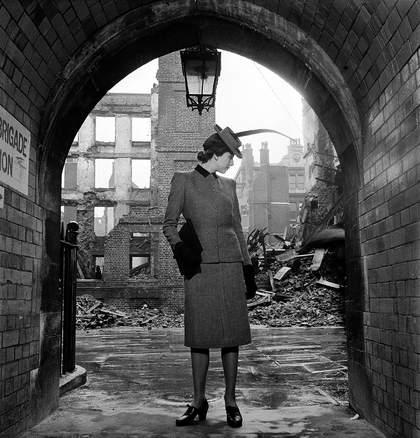
7. GRIM GLORY: BRITAIN AT WAR
Years ago I fought and struggled to live in Europe – chose my friends in these countries – and their way of living – so I can’t leave now just because there isn’t enough butter to go round
Lee Miller
German bombs fell heavily on London between September 1940 and May 1941, killing almost 30,000 people and leaving one in six homeless. Amid the tragedy of the Blitz, Londoners also noticed the surreal qualities of their ruined city. Miller, who had refused to retreat to the relative safety of the United States, photographed the rapidly changing world around her. On grounds of taste and morale, British censors discouraged graphic images of violence on the home front. Instead, Miller created poetic images that explored the absurdity and incongruity of the bombsites. Dark, funny titles evoke a defiant spirit. Irony offered a powerful means of coping with horror.
Many of Miller’s Blitz photographs were published as a book, Grim Glory: Pictures of Britain Under Fire (1941). Although intended primarily for a US audience, it proved highly popular on both sides of the Atlantic. At least ten of her photographs were also included in Britain at War, an influential exhibition at the Museum of Modern Art in New York. Touring North and South America over the next three years, these works shaped international perceptions of the Blitz.
Another group of works documents women’s lives in a time of rapid change. British women, conscripted for the first time from 1941, poured into the workplace. In roles such as mechanics, pilots, journalists and searchlight operators, they made vital contributions to the war effort. Miller’s formally daring portraits celebrate their pioneering work.
8. IN THE FIELD
Miller became an accredited war correspondent with the US Army in late 1942, but like other women journalists, she faced barriers to accessing the war zone. It was only in summer 1944 – after D-Day, the Allied invasion of Nazi-occupied France – that she was finally allowed close to battle.
Once in Europe, she got to work. Driven by a fierce opposition to Nazi politics and her dogged curiosity about unfolding events, she stayed until early 1946. Her reports covered France, Belgium, Luxembourg, Germany, Denmark, Austria, Hungary and Romania. In the words of David E. Scherman, the photojournalist she lived and worked with for much of this period, Miller ‘became a GI’.
Miller produced an avalanche of Vogue stories which combined powerful photography with blisteringly vivid first-person essays. With almost no experience as a writer, she found herself a fearless and natural journalist with a knack for being first on the scene. Her editors in London and New York were thrilled. Yet as she followed Allied forces through wave after wave of combat and liberation, bearing witness proved a profound challenge.
Miller’s war reportage drew on her instinct for metaphor, her attention to the unexpected and her unflinching commitment to truth. Working rapidly and intuitively, she created images that grapple with the complexities of violent conflict.
9. BELIEVE IT
I usually don’t take pictures of horrors. But don’t think that every town and every area isn’t rich with them. I hope Vogue will feel that it can publish these pictures.
Lee Miller
Miller entered Buchenwald, a Nazi concentration camp near the city of Weimar, on 16 April 1945, soon after it had been liberated. Two weeks later, on 30 April, she visited Dachau, a concentration camp near Munich whose survivors had been freed the previous day. These spaces were characterised by forced labour, systematic persecution and murder. Those imprisoned within Buchenwald and Dachau included Jews, political dissidents, gay men, Sinti and Roma people, Jehovah’s Witnesses and prisoners of war. By April 1945, these camps had also become entwined with the history of the Holocaust – the continental genocide of six million Jewish men, women and children.
By this point in the war, Miller had encountered many profoundly distressing scenes, but her experiences in the concentration camps marked her forever. Her Rolleiflex camera, which had no zoom lens, brought her as intimately close to her subjects as we are to her images. Fired with rage, yet working with sharp precision, Miller documented even the most harrowing aspects of the two sites. Photographs of starving prisoners, beaten guards and piles of bodies confront the viewer with the entangled nature of power, cruelty and spectacle.
Rumours were already circulating that the atrocities found at the concentration camps were a hoax. Miller was determined to help prove otherwise. In a cable to her editor in London she wrote: ‘I IMPLORE YOU TO BELIEVE THAT THIS IS TRUE’.
The texts in this room were developed in consultation with Dr Andy Pearce at the UCL Centre for Holocaust Education, which is the world leader for research-informed teacher and student education about the Holocaust. Find out more at holocausteducation.org.uk
10. AFTERMATH
The Second World War left unthinkable devastation in its wake. Following Allied forces across Europe, Miller recorded the euphoria of liberation giving way to disillusionment. Her images and writing show people facing mass displacement, starvation and disease. Survivors mourn their dead on a continent in ruins. For many, the atrocities of the war forever changed their sense of human nature. Miller shared her struggles with her editor in October 1944: ‘If I could find faith in the performance of liberation I might be able to whip something into a shape which would curl a streamer and wave a flag … I, myself, prefer describing the physical damage of destroyed towns and injured people to facing the shattered morale and blasted faith of those who thought “Things are going to be like they were”.’ With humane curiosity, she did both.
Miller’s photographs question the nature of complicity, justice and revenge. They also invite us to consider the power dynamics of the camera. She paid close attention to individuals on both sides of the conflict, especially women and children. Aware that desperate hardship could sow the seeds of a future war, she wrote: ‘I’m taking a lot of kid pictures, because they are the only ones for whom there is any hope … And also we might as well have a look at who we’re going to fight twenty years from now.’
11. ARTISTS & FRIENDS II
In February 1946, Miller returned to London an internationally celebrated photojournalist, but physically and emotionally scarred by her wartime experiences. She continued her work at Vogue until 1953, but now found little inspiration in fashion shoots. Miller’s most profound and tender works, in these years and afterwards, were portraits of fellow artists. From Isamu Noguchi in New York to Dorothea Tanning in Arizona, these images reflect her vibrant gift for friendship and her ongoing engagement with the international art world.
Miller married Roland Penrose in 1947 and gave birth to her son, Antony. She was closely involved in the beginnings of the Institute of Contemporary Arts in London, soon the UK’s most important centre for new art. The family began dividing their time between London and Farleys House in Sussex, which became a legendary art world meeting point. With weekend parties fuelled by Miller’s experimental meals, Farleys was a staging ground for new portraits.
She rarely spoke about it, but Miller’s mental health was permanently affected by what she had witnessed in the war. Over time, her interest in photography waned. She developed a new passion for gourmet cooking, which she pursued with her typical creative flair. Sometimes, she even claimed that her photographic archive had been destroyed. The true extent of her work was only discovered after her death in 1977. The roughly 60,000 negatives, prints, journals and ephemera uncovered in the family attic now form the basis of the Lee Miller Archives.

